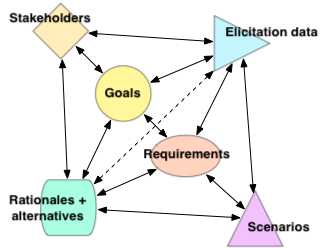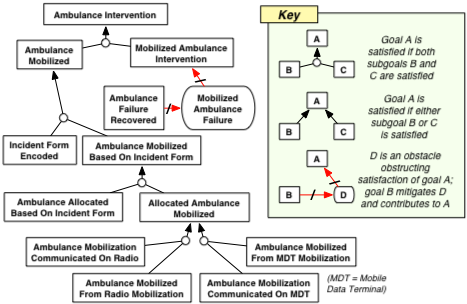Sets
Relations
Correspondences
Ordered Sets
Lattices
Graphs
Powersets
Binary Strings
Logic
AIA
Greek
Glossary
Abstracts
Argument
Inquiry Cycle
Legal Relations
Presentations
Elicitation
Glossaries
Goals
i*
SCR
Tracing
Design Patterns
Javadoc
Java Packages
Java Types
A goal is the result toward which effort is directed, an objective that should be achieved. A goal expresses what is desired, and in addition usually conveys why it is desired and the larger context in which the motivations and rationales behind it can be understood.
Here are some examples of goals:
- "Ensure that only the account owner can access the account."
- "Prevent the thrust reversers from operating during flight."
- "Achieve an "A" in this course."
- "Be familiar with the issues, areas, and techniques of requirements engineering."
Goals are most commonly expressed as imperative sentences beginning with a verb (as in the examples above).
Kinds of goals
Goals can be classified in several ways.
Functional / non-functional, behavioral / developmental-quality
- Functional goals express services that a system is to deliver.
- All other goals are non-functional. These include goals related to the "-ilities" (suitability, reliability, usability, interoperability, verifiability, ...).
| Examples | "Provide safe, reliable, and quick transportation around campus" | (functional) |
|---|---|---|
| "Print a receipt for every transaction" | (functional) | |
| "Be self-explanatory and easy to use". | (non-functional) |
A slightly different classification is also made for them. behavioral goals or developmental quality goals (or goals that are neither):
- Behavioral goals characterize what a system's behavior is to be. These goals are satisfied (or not) by what the system does when it runs.
- Developmental quality goals characterize the process by which a system is produced and evolved. These goals are satisfied (or not) by the actions of the people responsible for producing a system.
| Examples | "Turn out the lights when the room is unoccupied" | (behavioral) |
|---|---|---|
| "Be thoroughly testable so that customers will have a high level of confidence". | (developmental quality) |
Functional/non-functional and behavioral/developmental-quality don't quite divide goals the same way. Most notably, there are nonfunctional goals (such as, perhaps, "Cost less than per copy") that are arguably neither behavioral goals (because they don't address the system's behavior) nor developmental quality goals (because they don't characterize the development process). There are arguably behavioral goals (such as, perhaps, "Secretly provide access to internal program state needed to make testing more effective") that are more closely related to a nonfunctional goal such as testability than to any ordinary functional goal. It seems that every developmental-quality goal would also be a non-functional goal, and any functional goal would also be a behavioral goal (I have not come up with counterexamples, in any case).
Hard / soft
Some goals are either satisfied or not satisfied — there is no in-between.
Other goals (probably the vast majority) cannot be completely satisfied, but only satisfied to a degree; these are called soft goals.
Soft goals can be said to be satisficed (rhymes with "iced") rather than satisfied (a word due to Herb Simon in 1956). A soft goal is satisficed if it is achieved to a degree that is acceptable, with the understanding that this may cover a wide range of relative achievement, and that complete achievement is not possible. If a soft goal is not satisficed, then it is denied.
Achieve / maintain / optimize
Another way of classifying goals relates to their temporal characteristics.
- An Achieve goal refers to a property that is not initially true, but that becomes true.
- A Maintain goal refers to a property that starts out true and stays that way.
- A Stop goal refer to a property that is not initially false, but that becomes false.
- A Prevent goal refers to a property that s starts out false and stays that way.
- An Optimize goal refers to a soft property that is to be satisficed.
In terms of temporal logic, an Achieve goal is of the form "eventually P", while a Maintain goal is of the form "always P".
Some authors capitalize the verb of such goals, as I have done in some examples above.
Identifying goals and obstacles to them
Talk to stakeholders and read documents, and ask "why" questions. Look for motivations and rationales (rationale = a reasoned exposition of principles, an explanation or statement of reasons [OED]). Ask what could prevent a goal from being satisfied; those things are obstacles.
Once you have some goals, it is often possible to derive additional goals from them.
- Ask "why" about the goal (you may get a higher-level goal).
- Ask how the goal is to be achieved (you may get its subgoals).
- Abstract and generalize from the goal (you may get a larger goal).
Goal structures
Goals can be related to each other by contribution, either partial or complete. The satisfaction of one goal may contribute to another's satisfaction. If the contributing goal is simpler or of smaller scope than the goal it contributes to, the contributing goal is called a subgoal of the other.
The contribution of a subgoal may be positive, or it may be negative (in which case we can equivalently say the goals conflict). In the case of a conflict (i.e. negative contribution), satisfaction of the subgoal interferes with satisfaction of its supergoal.
An obstacle only contributes negatively, by definition. An obstacle differs from a negatively-contributing subgoal in that achievement of an obstacle is not desired, whereas achievement of a goal is.
Two special cases of contribution are particularly useful. In the first case, a group of subgoals is said to be an AND-refinement of their supergoal if the satisfaction of all of the AND subgoals is sufficient to ensure satisfaction of their supergoal. In the second case, a group of subgoals is said to be an OR-refinement of their supergoal if satisfaction of any one of the OR subgoals is sufficient to ensure satisfaction of their supergoal.
These relationships can be drawn in a diagram like Fig. 1. In this diagram of some goals for the London Ambulance System, complete contribution is shown by solid arrows. The arrows for the contributions of AND-subgoals are grouped by a circle; the arrows for contributions of OR-subgoals go all the way to their supergoal. See the four subgoals of "Allocated Ambulance Mobilized" at the bottom of the figure: it has two OR-ed contributions, one the AND of the two subgoals on the left, and the other the AND of the two subgoals on the right.
The figure also shows a goal whose partial contribution is indicated by a dotted line, and whose mitigation of an obstacle is shown by an arrow to the obstacle. The obstacle's negative contribution to the goal it obstructs is indicated by an arrow with a bar across it (that arrow is red for emphasis).
These goals could be either hard or soft goals. In the case of a soft subgoal, satisficing of the subgoal contributes to its supergoal; in the case of a soft supergoal, its subgoal contributes to the satisficing of the supergoal.
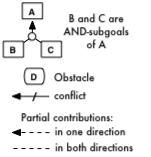
Fig. 2. Key for Figs. 3-5
Example analysis of goal relationships
It is possible to draw arrows among all goals that contribute to each other, and end up with a diagram that looks like a tangle and that is so complex it is not helpful. The way to combat this is to refine each goal into its AND and OR subgoals, put each larger goal above its smaller subgoals, and then eliminate all the arrows that are implied by inheritance. When you have two goals that are related, but not in a way that you can express easily, the best approach is usually to refine each of them into subgoals, and try to find a common subgoal (if the original goals contributed partially to each other) or two subgoals that are in conflict (if the original goals conflicted partially with each other).
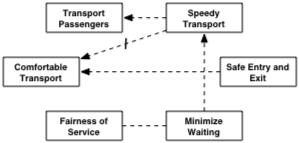
Fig. 3. Goal analysis (first step)
Example goal analysis — Step 1
In the first step, six goals for an elevator were produced. Some of the goals partially contribute to others, and one goal partially conflicts with another; the diagram indicates the partial contributions with dashed lines and arrows, and conflicts with slashes across the lines and arrows. The goals are:
- Comfortable Transport
- Move passengers in such a way that they are not made uncomfortable by the process.
- Fairness of Service
- Be fair to all passengers.
- Minimize Waiting
- Minimize the time passengers spend waiting for the elevator.
- Safe Entry and Exit
- Leave the doors open long enough that all passengers can enter and exit the elevator safely.
- Speedy Transport
- Move passengers quickly to their destinations.
- Transport Passengers
- Move passengers from floor to floor.
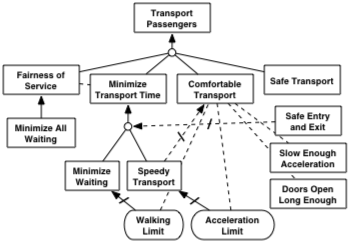
Fig. 4. Goal analysis (second step)
Example goal analysis — Step 2
In the second step, several changes have been made. The first change is that the goals have been re-expressed more exactly, and some new goals and obstacles have been added. A number of partial contributions have been added, to the goal structure, indicating that we know the goals they connect are related but aren't sure how yet.
- Acceleration Limit
- There is a limit to how rapidly a passenger can be accelerated in an elevator without feeling uncomfortable or worse.
- Comfortable Transport
- Move passengers in such a way that they are not made uncomfortable by any part of the process.
- Doors Open Long Enough
- Leave the elevator doors open long enough when passengers are entering and exiting so that no passenger must move uncomfortably quickly.
- Fairness of Service
- Minimize the amount of variation in the time it takes for passengers to make analogous trips.
- Minimize Transport Time
- Minimize the time between when a passenger presses a call button and when the passenger exits at his/her destination floor.
- Minimize All Waiting
- Minimize the average time all passengers spend waiting for an elevator.
- Minimize Waiting
- Minimize the time passengers spend waiting for an elevator.
- Safe Transport
- Transport each passenger without injury.
- Safe Entry and Exit
- Leave the doors open long enough that all passengers can enter and exit the elevator safely.
- Slow Enough Acceleration
- Reduce the maximum acceleration of the elevator enough that no passenger is made uncomfortable.
- Speedy Transport
- Minimize the time between when a passenger enters the elevator and when the passenger exits at his/her destination floor.
- Transport Passengers
- Move passengers from floor to floor in a satisfactory manner.
- Walking Limit
- Passengers, especially disabled or elderly passengers, can only walk so fast.
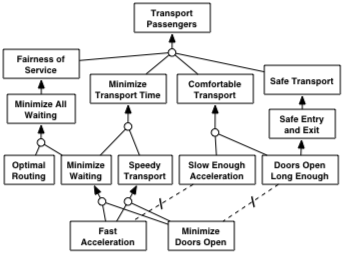
Fig. 5. Goal analysis (third step)
Example goal analysis — Step 3
In the third and final step for this example, two more subgoals have been added that specify how Minimize Waiting and Speedy Transport can be achieved. These subgoals are in conflict with the existing goals Slow Enough Acceleration and Minimize Doors Open, and make the two obstacles in the preceding step unnecessary. An additional subgoal Optimal Routing has been added for Minimize All Waiting, so that the partial contribution from Minimize Waiting can become complete contribution as an AND-subgoal. All the goals added in the previous step have been integrated into the goal structure so that each is an AND or singleton subgoal of another goal. Each of the partial contributions in step 2 has been expressed by the sharing of a specific subgoal, or by subgoals that conflict.
- Fast Acceleration
- Accelerate the elevator as fast as possible between floors.
- Minimize Doors Open
- Minimize the time the doors are open.
- Optimal Routing
- Route the elevator among the floors in a way that minimizes a summing function of all wait times.
